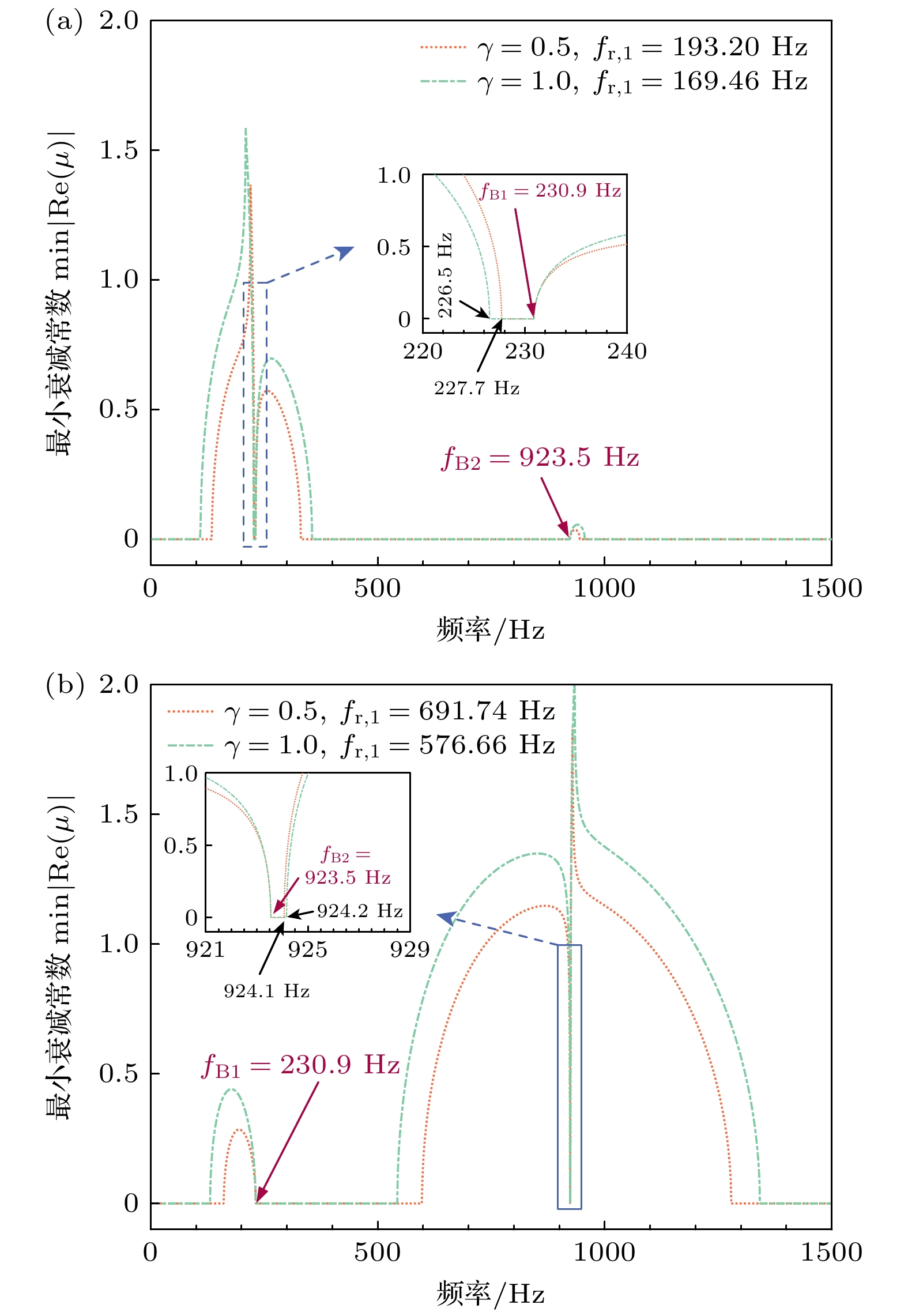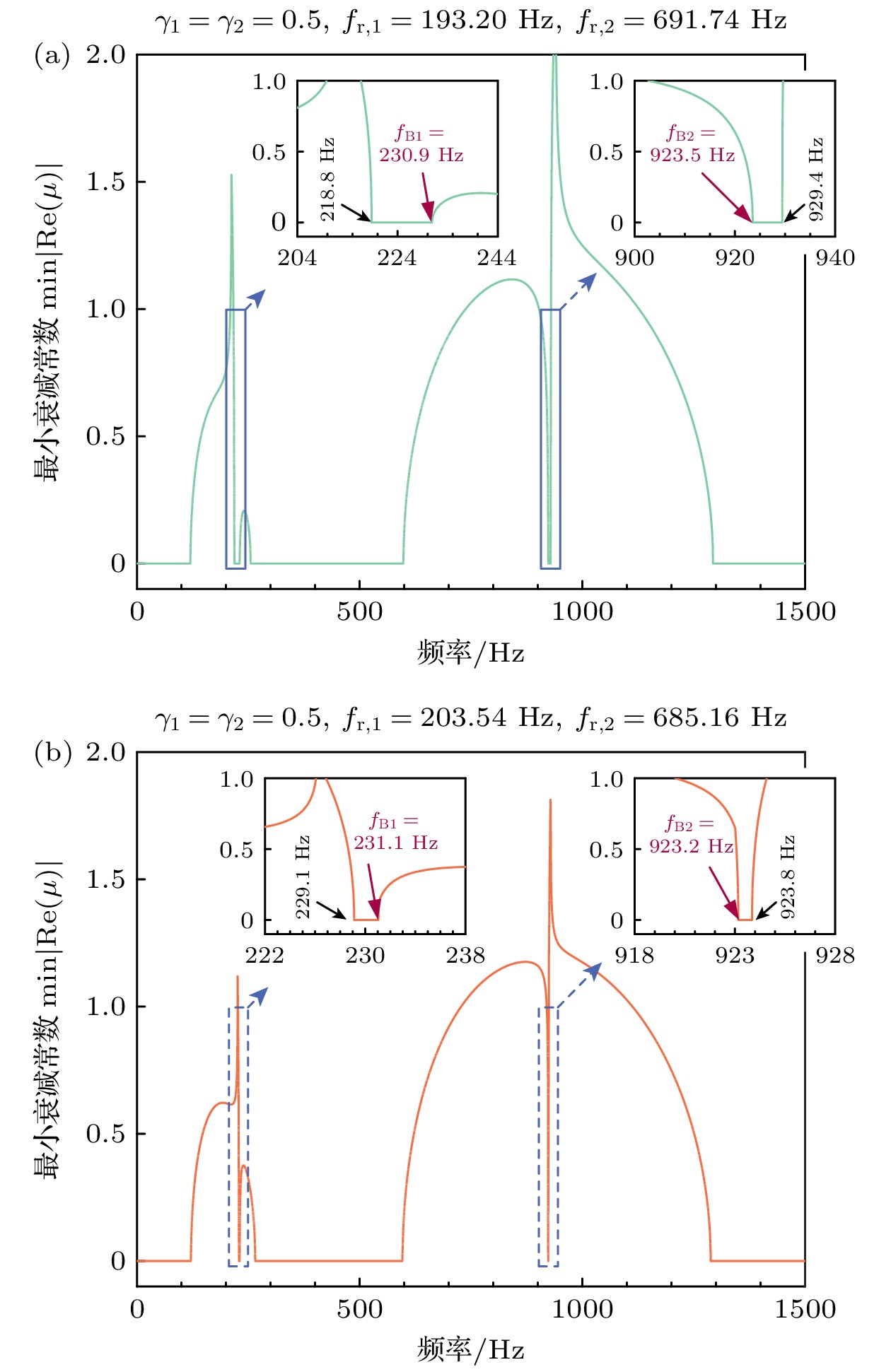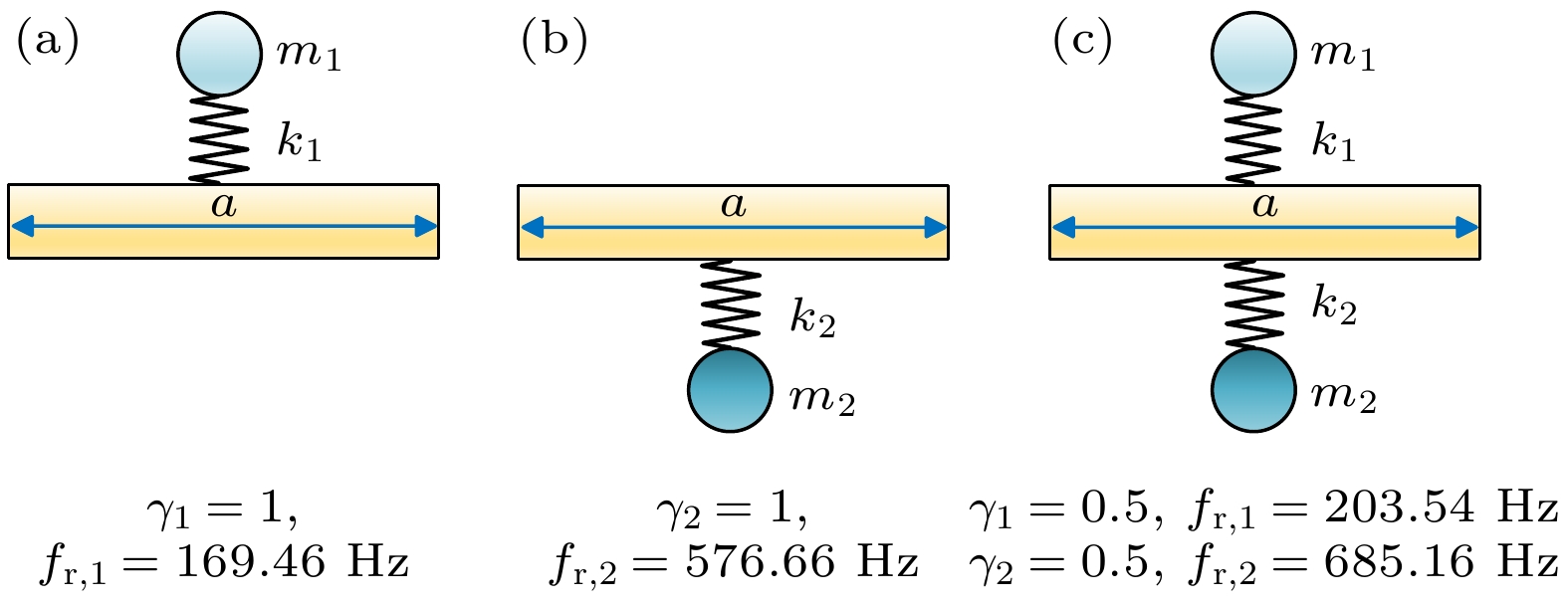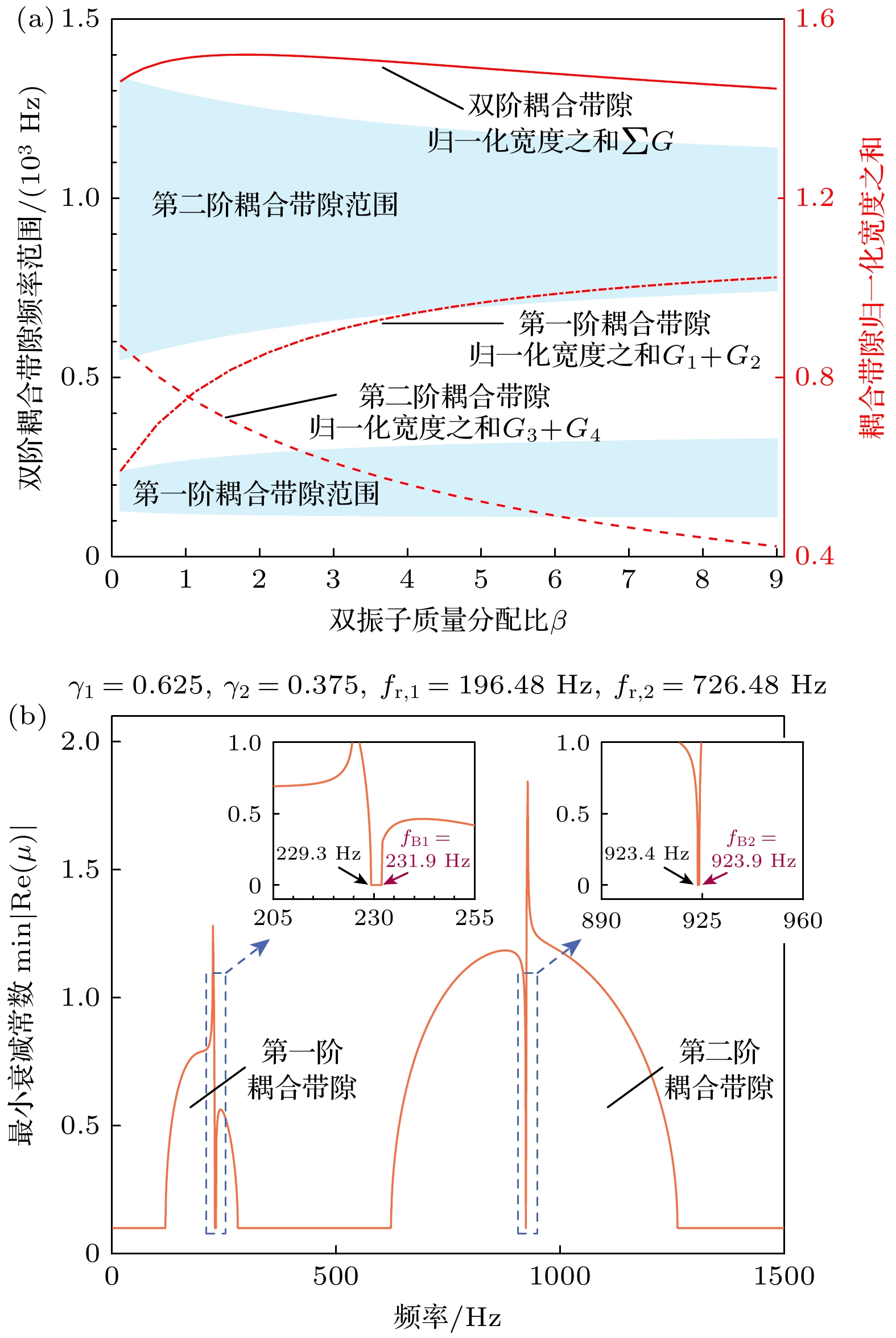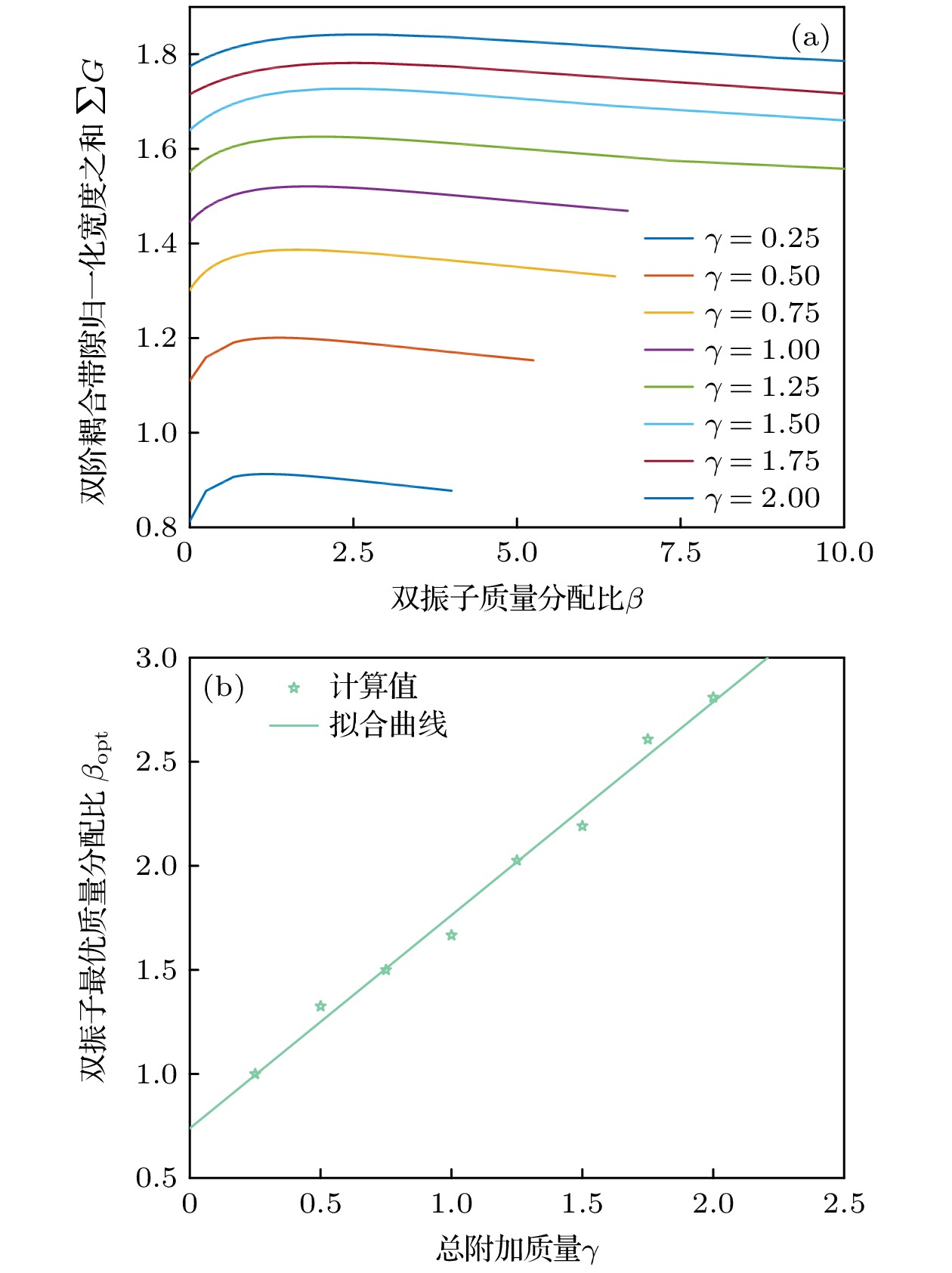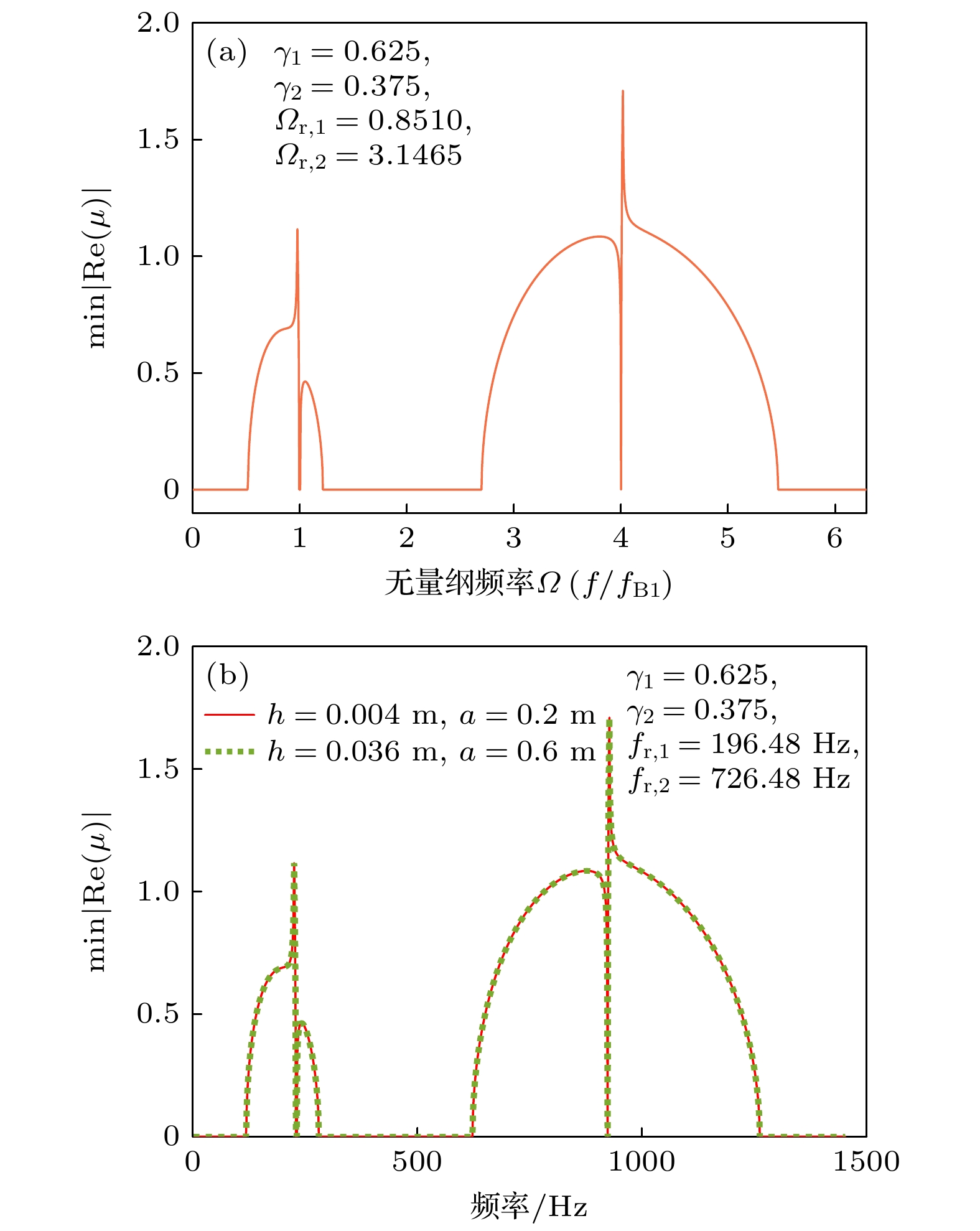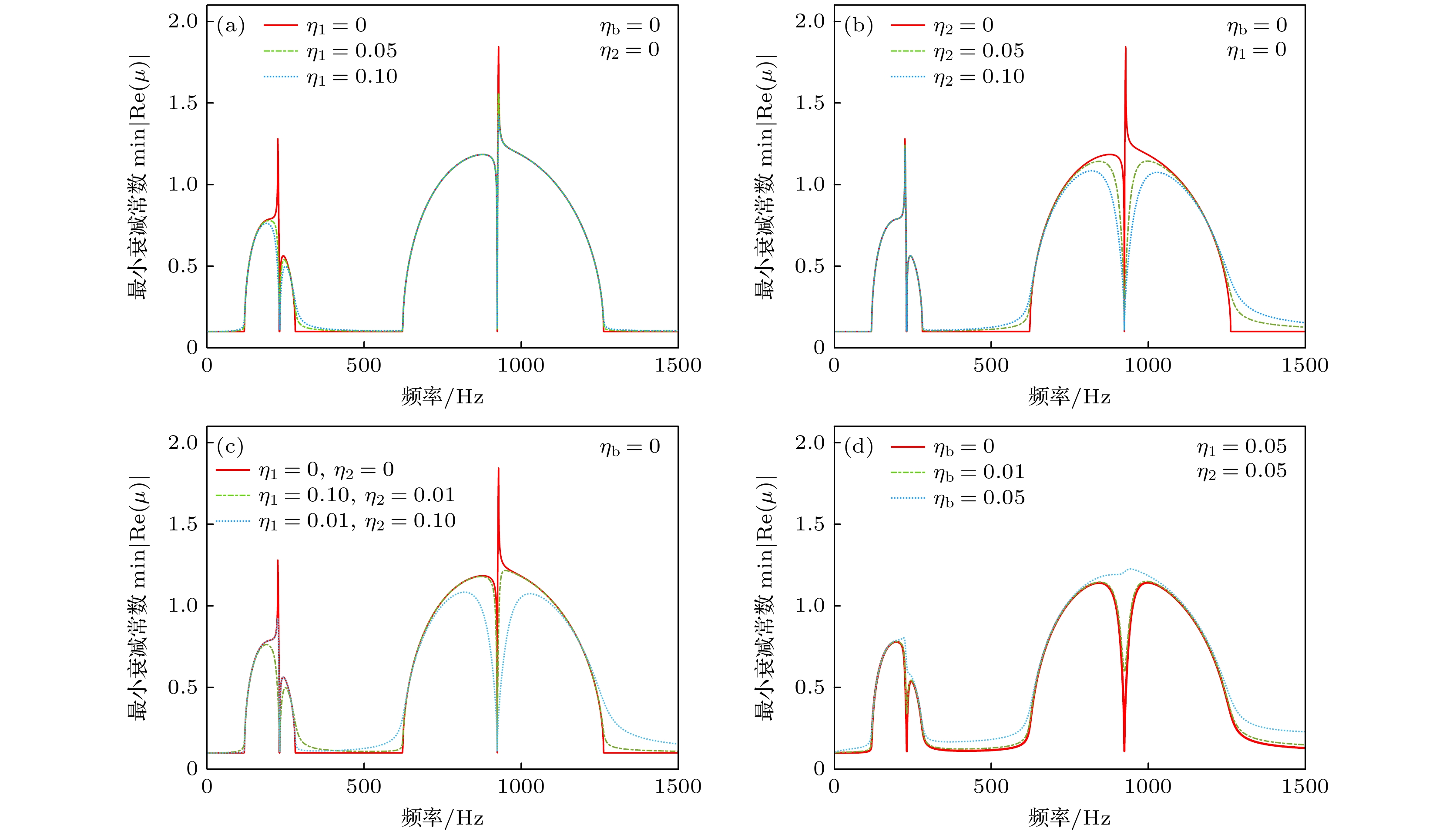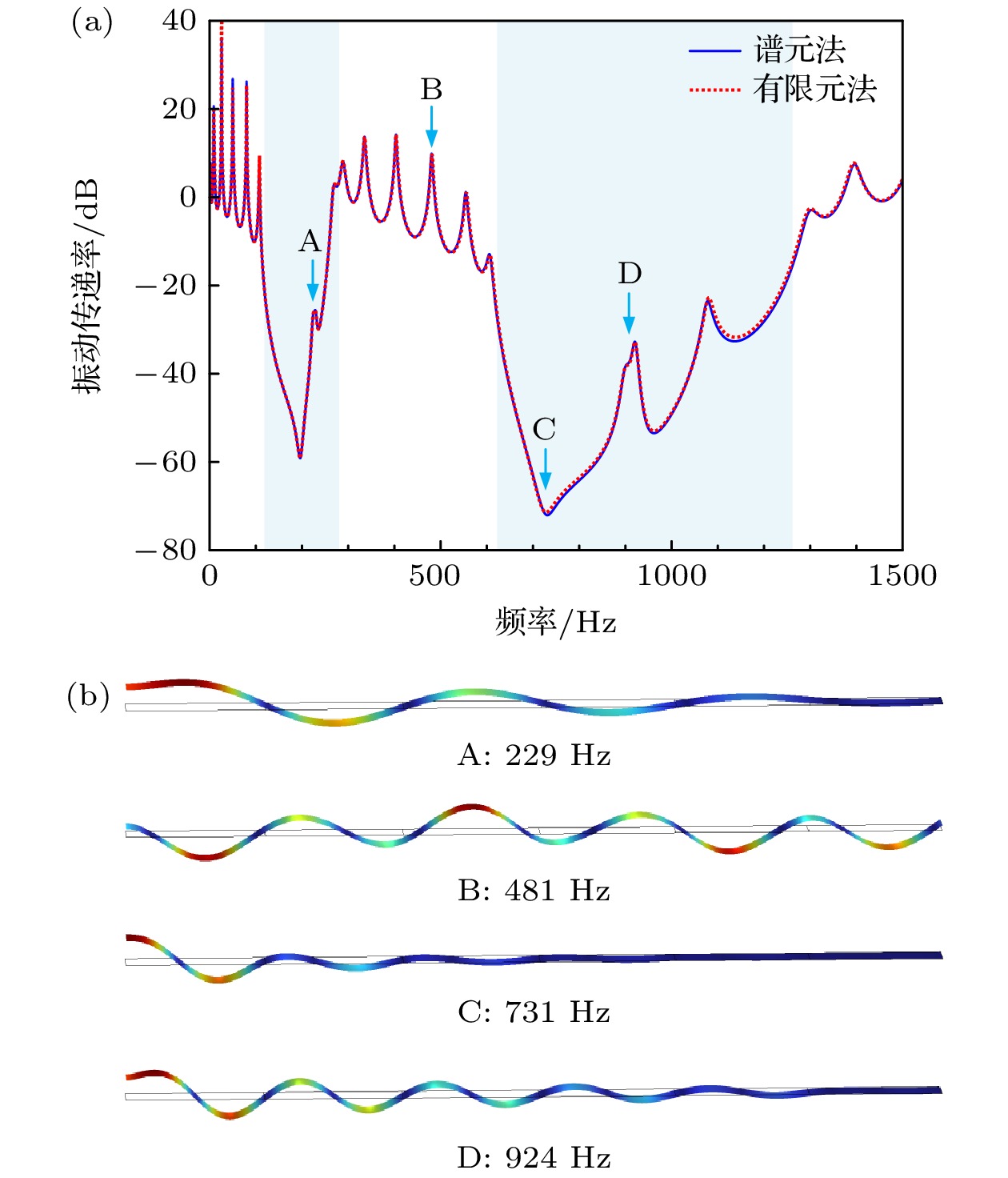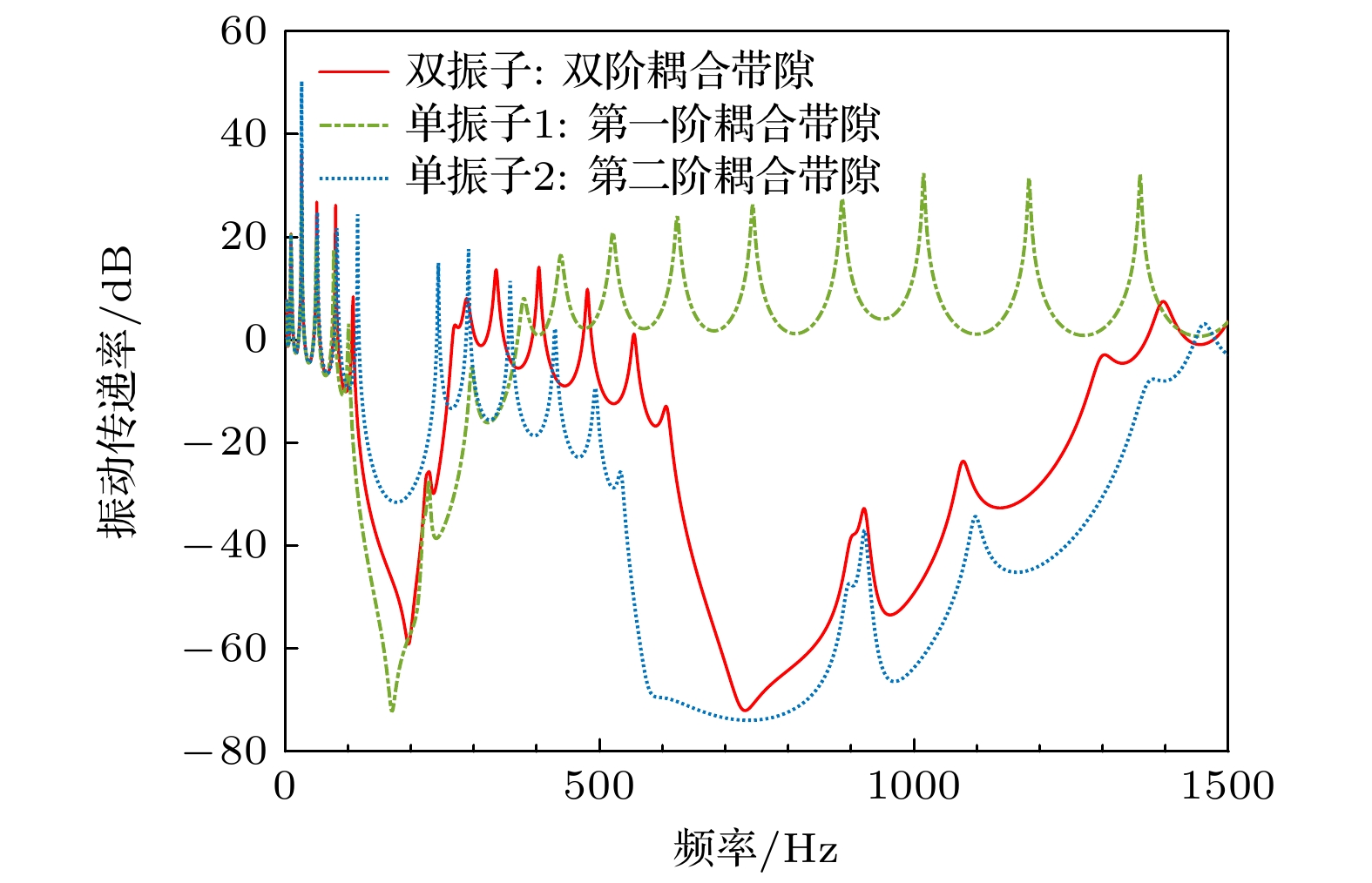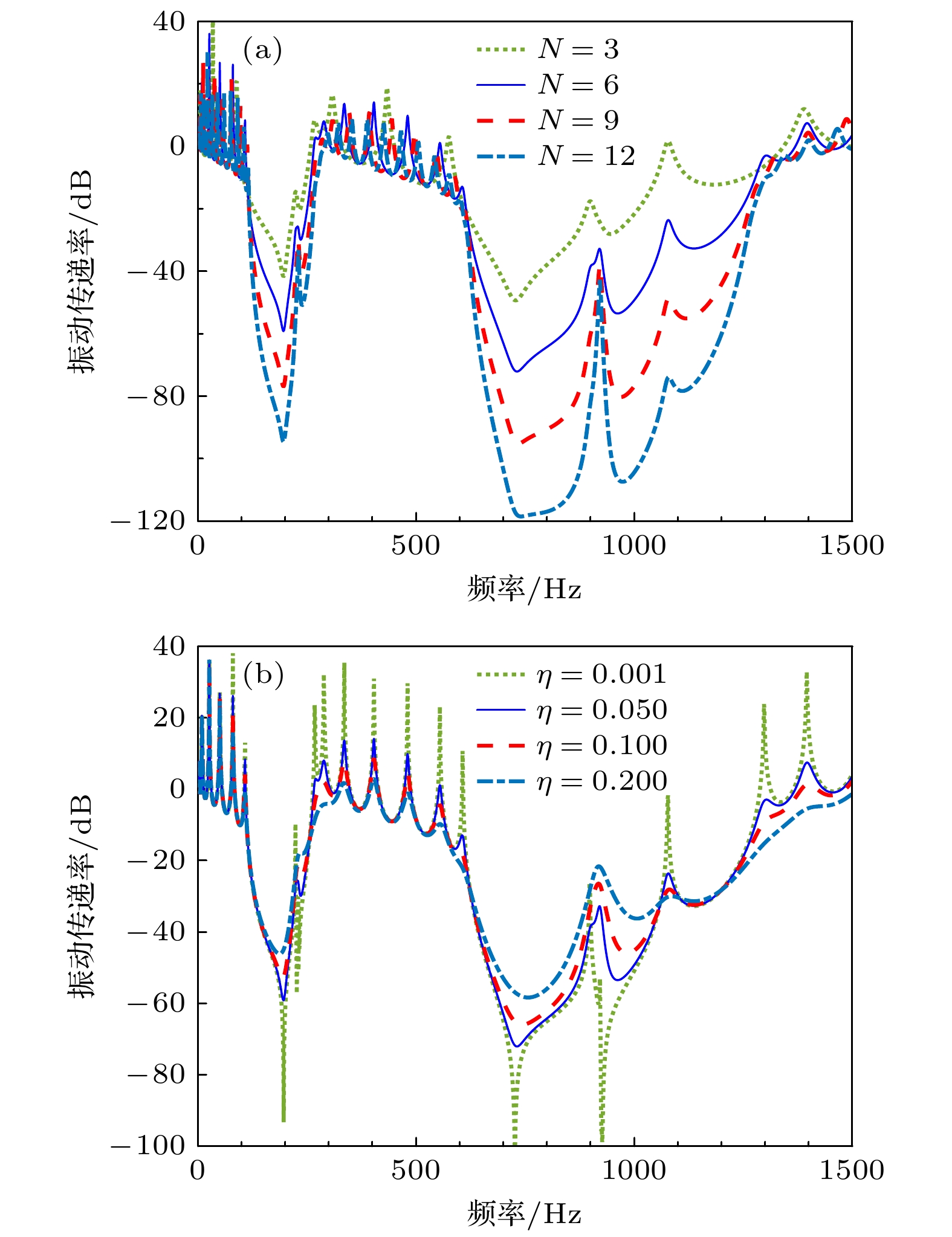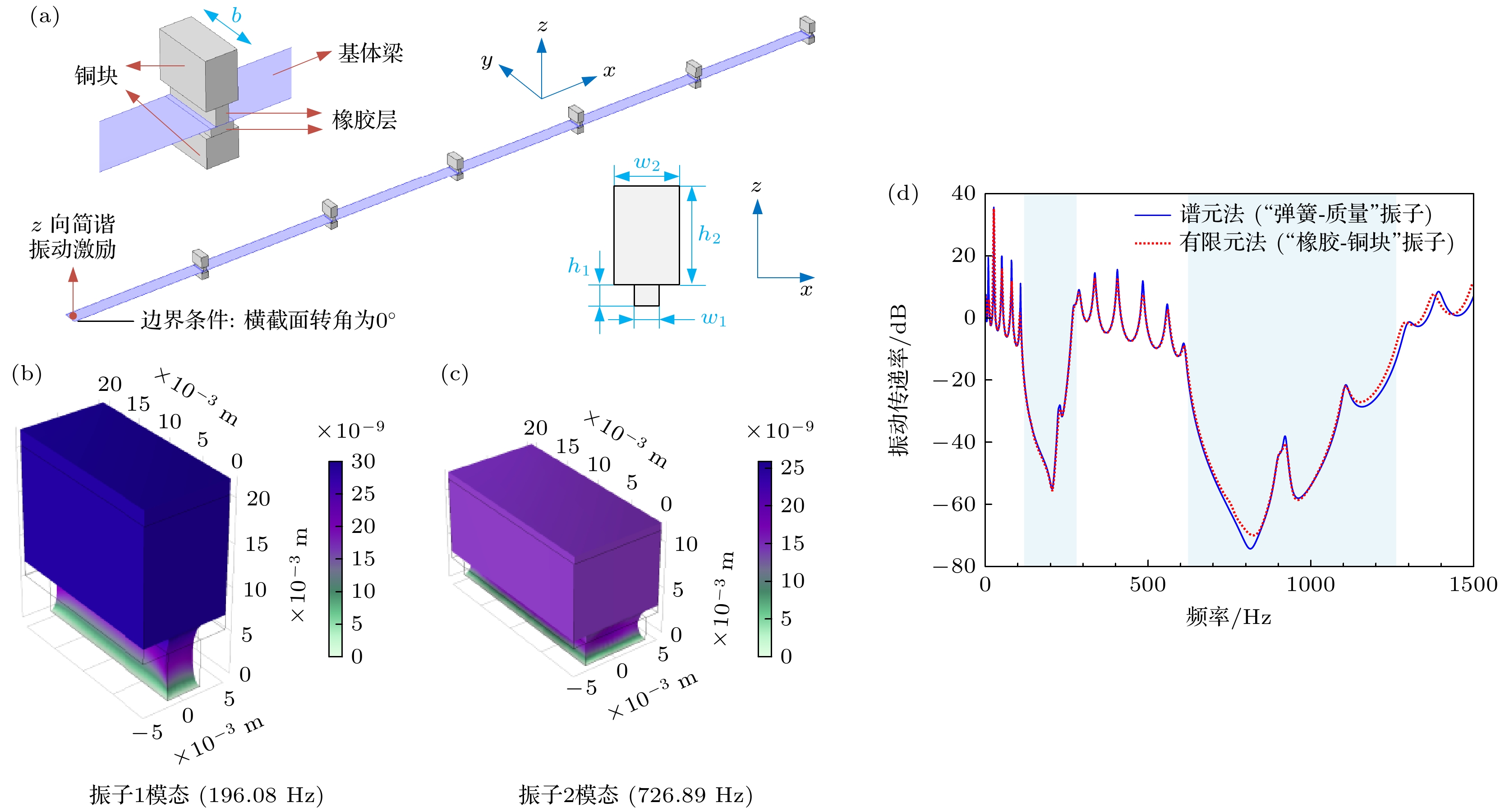-
局域共振带隙和Bragg带隙可同时存在于超材料梁中, 利用两种带隙之间的相互耦合效应可以实现超宽耦合带隙设计, 在宽带减振领域极具应用潜力. 以往研究通常考虑单振子超材料梁的单阶耦合带隙设计, 因而只能实现单阶的超宽耦合带隙, 无法满足双目标或多目标频带的宽带减振需求. 为此, 本文开展了双振子超材料梁的双阶耦合带隙调控设计研究, 提出了一种实现双阶耦合宽带隙的设计方法, 分析了所设计双阶耦合带隙相比传统单阶耦合带隙的带宽优势, 并探究了双振子质量分配比对双阶耦合带隙总宽度的影响, 进一步设计出最优的质量分配比, 使得实现的双阶耦合带隙的总宽度最宽. 此外, 还采用谱元法研究了基于双阶耦合带隙设计的双振子超材料梁的减振特性, 通过与有限元法进行对比, 验证了谱元法的准确性, 研究表明基于双阶耦合带隙设计可以实现两个宽频带范围的高效减振.
Local-resonance bandgap and Bragg bandgap can coexist in a metamaterial beam, and their coupling effect can be used to realize ultra-wide bandgap, which has great potential applications in the field of wide-band vibration reduction. Previous studies usually considered the single-order coupling between the local-resonance bandgap and Bragg bandgap in metamaterial beams with a single array of local resonators, which can only achieve the single-order ultra-wide coupling bandgap and cannot meet the wide-band vibration reduction requirements of double/multiple target frequency bands. In this paper, metamaterial beams with double arrays of local resonators are considered, and the regulation design and analysis of double-order coupling of local-resonance and Bragg bandgaps are carried out based on an analytical model of bending wave dispersion relation. Moreover, the vibration reduction characteristics of the double-frequency-resonator metamaterial beams with double-order coupling bandgaps are studied by using spectral element method and the finite element method. The main conclusions are as follows. 1) A design method is proposed for realizing double-order coupling wide bandgap in a metamaterial beam with double arrays of local resonators. By using this method, the resonance frequencies of the local resonators can be quickly designed on conditions that host beam parameters, lattice constant and added mass ratio of the local resonators are given. 2) The double-order coupling bandgaps in a metamaterial beam carrying double arrays of local resonators are compared with the single-order coupling bandgaps in metamaterial beams with a single array of local resonators. It is found that through proper design, the total normalized width of the double-order coupling bandgap can be much broader than that of the single-order coupling bandgap, so the double-order coupling bandgap is more beneficial to wide-band vibration reduction. 3) It is found that for a given total added mass ratio of the double arrays of local resonators, it is necessary to optimize the mass distribution ratio of the double resonators to maximize the total normalized width of double-order coupling bandgap. An approximate formula for designing the optimal mass distribution ratio of the double resonators is further established. 4) The spectral element method is used to study the vibration reduction characteristics of the metamaterial beams carrying double arrays of local resonators designed based on double-order bandgap coupling. The accuracy of the spectral element method is verified by comparing with the finite element method. The results show that significant vibration reduction can be achieved in two wide frequency bands corresponding to the double-order coupling bandgaps. The influences of number of unit cells and resonator damping on the vibration reduction characteristics of the metamaterial beam are further analyzed. It is shown that the increase of number of unit cells can enhance the vibration reduction performance in the bandgap, and the increase of resonator damping can effectively broaden the vibration reduction frequency band. -
Keywords:
- metamaterial beam /
- flexural wave bandgap /
- coupled bandgap /
- broadband vibration reduction
[1] 文岐华, 左曙光, 魏欢 2012 物理学报 61 034301
 Google Scholar
Google Scholar
Wen Q H, Zuo S G, Wei H 2012 Acta Phys. Sin. 61 034301
 Google Scholar
Google Scholar
[2] Xiao Y, Wen J H, Wen X S 2012 J. Phy. D: Appl. Phys. 45 195401
 Google Scholar
Google Scholar
[3] Xiao Y, Mace B R, Wen J H, Wen X S 2011 Phys. Lett. A 375 1485
 Google Scholar
Google Scholar
[4] 张思文, 吴九汇 2013 物理学报 62 134301
 Google Scholar
Google Scholar
Zhang S W, Wu J H 2013 Acta Phys. Sin. 62 134301
 Google Scholar
Google Scholar
[5] 刘娇, 侯志林, 傅秀军 2015 物理学报 64 154302
 Google Scholar
Google Scholar
Liu J, Hou Z L, Fu X J 2015 Acta Phys. Sin. 64 154302
 Google Scholar
Google Scholar
[6] 丁昌林, 董仪宝, 赵晓鹏 2018 物理学报 67 194301
 Google Scholar
Google Scholar
Ding C L, Dong Y B, Zhao X P 2018 Acta Phys. Sin. 67 194301
 Google Scholar
Google Scholar
[7] 肖勇, 王洋, 赵宏刚, 郁殿龙, 温激鸿 2023 机械工程学报 59 277
Xiao Y, Wang Y, Zhao H G, Yu D L, Wen J H 2023 J. Mech. Eng. 59 277
[8] 胥强荣, 沈承, 韩峰, 卢天健 2021 物理学报 70 244302
 Google Scholar
Google Scholar
Xu Q R, Shen C, Han F, Lu T J 2021 Acta Phys. Sin. 70 244302
 Google Scholar
Google Scholar
[9] 朱席席, 肖勇, 温激鸿, 郁殿龙 2016 物理学报 65 176202
 Google Scholar
Google Scholar
Zhu X X, Xiao Y, Wen J H, Yu D L 2016 Acta Phys. Sin. 65 176202
 Google Scholar
Google Scholar
[10] 林国昌, 孙宏伟, 谭惠丰, 杜星文 2011 物理学报 60 034302
 Google Scholar
Google Scholar
Lin G C, Sun H W, Tan H F, Du X W 2011 Acta Phys. Sin. 60 034302
 Google Scholar
Google Scholar
[11] Xiao Y, Wen J H, Wen X S 2012 New J. Phys. 14 33042
 Google Scholar
Google Scholar
[12] Xiao Y, Wen J H, Yu D L, Wen X S 2013 J. Sound Vibr. 332 867
 Google Scholar
Google Scholar
[13] Zhou J X, Wang K, Xu D L, Ouyang H J 2017 Phys. Lett. A 381 3141
 Google Scholar
Google Scholar
[14] Xiao Y, Wen J H, Wen X S 2012 Phys. Lett. A 376 1384
 Google Scholar
Google Scholar
[15] Frandsen N M M, Bilal O R, Jensen J S, Hussein M I 2016 J. Appl. Phys. 119 124902
 Google Scholar
Google Scholar
[16] Taniker S, Yilmaz C 2015 Int. J. Solids Struct. 72 88
 Google Scholar
Google Scholar
[17] Acar G, Yilmaz C 2013 J. Sound Vibr. 332 6389
 Google Scholar
Google Scholar
[18] Fang X, Wen J H, Bonello B, Yin J F, Yu D L 2017 Nat. Commun. 8 1288
 Google Scholar
Google Scholar
[19] Zhang X D, Yu H Y, He Z C, Huang G L, Chen Y Y, Wang G 2021 Mech. Syst. Signal Proc. 159 107826
 Google Scholar
Google Scholar
[20] Krushynska A O, Miniaci M, Bosia F, Pugno N M 2017 Extreme Mech. Lett. 12 30
 Google Scholar
Google Scholar
[21] Li Y, Xiao Y, Guo J J, Zhu Z, Wen J H 2022 Int. J. Mech. Sci. 234 107683
 Google Scholar
Google Scholar
[22] Guo J J, Li Y Q, Xiao Y, Fan Y L, Yu D L, Wen J H 2022 Compos. Struct. 289 115463
 Google Scholar
Google Scholar
[23] 肖勇 2012 博士学位论文 (长沙: 国防科学技术大学)
Xiao Y 2012 Ph. D. Dissertation (Changsha: National University of Defense Technology
-
图 4 3种超材料梁结构的周期元胞示意图 (a) 具有第一阶耦合带隙的单振子超材料梁的元胞(单阶耦合带隙, n = 1); (b) 具有第二阶耦合带隙的单振子超材料梁的元胞(单阶耦合带隙, n = 2); (c) 同时具有第一阶和第二阶耦合带隙的双振子超材料梁的元胞(双阶耦合带隙)
Fig. 4. Schemetic of unit cells of three metamaterial beams used for comparison of bandgaps: (a) Metamaterial beam carring single-frequency local resonators with the first order coupling bandgap (n = 1); (b) metamaterial beam carring single-frequency local resonators with the second order coupling bandgap (n = 2); (c) metamaterial beam carring two single-frequency local resonators with the double-order coupling bandgap.
图 5 不同设计方法得到的双振子超材料梁的带隙特性对比 (a) 本文设计的双阶耦合带隙和传统深亚波长条件下设计的双频局域共振带隙的对比; (b) 深亚波长条件下双振子的共振频率被调节至比较靠近时的带隙特性
Fig. 5. Comparison of bandgaps of metamaterial beams carring two single-frequency local resonators following different design methods: (a) Comparison of double-order coupling bandgaps obtained by present design and two resonance bandgaps obtained by conventional deep-subwavelenght design; (b) two cases of resonance bandgaps obtained by conventional deep-subwavelenght design of double-resonators with close resonance frequencies.
图 6 双振子质量分配比对双阶耦合带隙的影响及其最优值所对应的带隙特性 (a) 对带隙频率范围及归一化宽度之和的影响 (总附加质量比限定为 γ = 1); (b) 最优质量分配比对应的双阶耦合带隙特性
Fig. 6. Influence of mass ratio of two resonators on the double-order coupling bandgaps and the corresponding optimal bandgap behavior: (a) The effect on the bandgap frequency range and the sum of normalized bandgap width (the total added mass ratio is limited to γ = 1); (b) the double-order coupled bandgap characteristics corresponding to the optimal mass distribution ratio.
图 7 双振子质量分配比β对双阶耦合带隙的调控 (a) 给定不同总附加质量比情形下双振子质量分配比β对ΣG的影响; (b) 最优质量分配比βopt与给定总附加质量比γ之间的关系
Fig. 7. Tuning of double-order coupling bandgaps by design of added mass ratio of double resonators β: (a) The influence of mass distribution ratio β on ΣG for different given total added mass ratio; (b) the relationship between the optimal mass allocation ratio βopt and the given total added mass ratio γ.
图 9 阻尼对双阶耦合带隙的影响 (a) 只有振子1存在阻尼时的影响; (b) 只有振子2存在阻尼时的影响; (c) 双振子同时存在阻尼的影响; (d) 基体梁阻尼的影响
Fig. 9. Effects of damping on double-order coupling bandgaps: (a) Effects of damping of the first resonator (damping exists only in the first resonator); (b) effects of damping of the second resonator (damping exists only in the second resonator); (c) effects of damping of the two resonators; (d) effects of the damping of the host beam.
图 12 含6个元胞的双振子超材料梁结构的振动特性 (a) 谱元法和有限元法计算得到的振动传递率对比(图中阴影区域为理论计算得到的带隙频率范围); (b) 图(a)中所选取的几个频率下基体梁的受迫振动后的形变图
Fig. 12. Vibration properties of a double-resonator metamaterial beam containing 6 unit cells: (a) Comparison of vibration transmissibility predicted by spectral element method and finite element method (the shaded area represents theoretically predicted bandgap regions); (b) deformation of the host beam under forced vibration at several frequencies selected in panel (a).
图 14 结构总长度(用周期数表征)及振子阻尼对双振子超材料梁减振特性的影响 (a)结构长度的影响(η = η1 = η2 = 0.05); (b) 振子阻尼的影响(N = 6)
Fig. 14. Influence of structural length (characterized by number of unit cells) and resonator damping on the vibration reduction properties of finite double-resonator metamaterial beam: (a) Influence of structural length; (b) influence of resonator damping.
图 15 采用“橡胶-铜块”振子构建的双振子超材料梁结构及其减振性能 (a)结构示意图; (b)振子1的模态; (c)振子2的模态; (d)谱元法与有限元法计算得到的减振性能对比
Fig. 15. A realizable metamaterial beam with “rubber-copper” resonators and its vibration attenuation performance: (a) Schematic of the construction; (b) vibration mode of the resonator 1; (c) vibration mode of the resonator 2; (d) comparison of vibration reduction properties calculated by spectral element method and finite element method.
表 1 基体梁结构参数及晶格常数
Table 1. Parameters of host beam and lattice constant.
密度
ρ/(kg·m–3)杨氏模量
E/Pa宽
b/mm厚
h/mm晶格常
数a/mm2700 7×1010 20 4 200 表 2 单阶耦合带隙设计与双阶耦合带隙设计所实现的带隙对比(振子总附加质量比均为1)
Table 2. Comparison of bandgaps achieved by design of single-order coupling bandgap and double-order coupling bandgap (the added resonator mass ratio is γ = 1).
耦合带隙
设计情形单阶耦合
带隙(n = 1)单阶耦合
带隙(n =2 )双阶耦合
带隙第1带隙
边界频率f1,1/Hz 108.300 130.190 120.970 f1,2/Hz 226.531 230.890 229.121 第2带隙
边界频率f2,1/Hz 230.881 542.630 231.051 f2,2/Hz 355.171 923.548 265.621 第3带隙
边界频率f3,1/Hz 922.821 924.158 595.631 f3,2/Hz 955.951 1341.580 923.168 第4带隙
边界频率f4,1/Hz — — 923.848 f4,2/Hz — — 1288.140 带隙
总宽度$\sum G$ 1.1656 1.4458 1.5177 表 3 两种双振子超材料梁结构的参数
Table 3. Parameters of two metamaterial beams carrying double arrays of local resonators.
h/mm a/m γ1 γ2 fr,1/Hz fr,2/Hz 原始基体梁 4 0.2 0.625 0.375 196.48 726.48 新基体梁 36 0.6 0.625 0.375 196.48 726.48 表 4 双振子参数
Table 4. Parameters of double local resonators.
γ1 γ2 fr,1/Hz fr,2/Hz 0.625 0.375 196.48 726.48 表 5 单振子参数
Table 5. Parameters of single local resonators.
附加质量比 γ 共振频率 fr/Hz 单振子1 1 169.46 单振子2 1 576.66 表 6 振子材料参数
Table 6. Properties of materials used for resonators
密度ρ/(kg·m–3) 杨氏模量E/Pa 泊松比 损耗因子 橡胶 1300 2×106 0.49 0.05 铜 8960 110×109 0.35 0.05 表 7 基于橡胶层与铜块构成的双振子参数
Table 7. Parameters of local resonators made by rubber and copper layers.
b/mm w1/mm h1/mm w2/mm h2/mm fr /Hz 振子1 20 4 5.5 10 15.1 196.08 振子2 20 7.2 2.5 10 9 726.89 -
[1] 文岐华, 左曙光, 魏欢 2012 物理学报 61 034301
 Google Scholar
Google Scholar
Wen Q H, Zuo S G, Wei H 2012 Acta Phys. Sin. 61 034301
 Google Scholar
Google Scholar
[2] Xiao Y, Wen J H, Wen X S 2012 J. Phy. D: Appl. Phys. 45 195401
 Google Scholar
Google Scholar
[3] Xiao Y, Mace B R, Wen J H, Wen X S 2011 Phys. Lett. A 375 1485
 Google Scholar
Google Scholar
[4] 张思文, 吴九汇 2013 物理学报 62 134301
 Google Scholar
Google Scholar
Zhang S W, Wu J H 2013 Acta Phys. Sin. 62 134301
 Google Scholar
Google Scholar
[5] 刘娇, 侯志林, 傅秀军 2015 物理学报 64 154302
 Google Scholar
Google Scholar
Liu J, Hou Z L, Fu X J 2015 Acta Phys. Sin. 64 154302
 Google Scholar
Google Scholar
[6] 丁昌林, 董仪宝, 赵晓鹏 2018 物理学报 67 194301
 Google Scholar
Google Scholar
Ding C L, Dong Y B, Zhao X P 2018 Acta Phys. Sin. 67 194301
 Google Scholar
Google Scholar
[7] 肖勇, 王洋, 赵宏刚, 郁殿龙, 温激鸿 2023 机械工程学报 59 277
Xiao Y, Wang Y, Zhao H G, Yu D L, Wen J H 2023 J. Mech. Eng. 59 277
[8] 胥强荣, 沈承, 韩峰, 卢天健 2021 物理学报 70 244302
 Google Scholar
Google Scholar
Xu Q R, Shen C, Han F, Lu T J 2021 Acta Phys. Sin. 70 244302
 Google Scholar
Google Scholar
[9] 朱席席, 肖勇, 温激鸿, 郁殿龙 2016 物理学报 65 176202
 Google Scholar
Google Scholar
Zhu X X, Xiao Y, Wen J H, Yu D L 2016 Acta Phys. Sin. 65 176202
 Google Scholar
Google Scholar
[10] 林国昌, 孙宏伟, 谭惠丰, 杜星文 2011 物理学报 60 034302
 Google Scholar
Google Scholar
Lin G C, Sun H W, Tan H F, Du X W 2011 Acta Phys. Sin. 60 034302
 Google Scholar
Google Scholar
[11] Xiao Y, Wen J H, Wen X S 2012 New J. Phys. 14 33042
 Google Scholar
Google Scholar
[12] Xiao Y, Wen J H, Yu D L, Wen X S 2013 J. Sound Vibr. 332 867
 Google Scholar
Google Scholar
[13] Zhou J X, Wang K, Xu D L, Ouyang H J 2017 Phys. Lett. A 381 3141
 Google Scholar
Google Scholar
[14] Xiao Y, Wen J H, Wen X S 2012 Phys. Lett. A 376 1384
 Google Scholar
Google Scholar
[15] Frandsen N M M, Bilal O R, Jensen J S, Hussein M I 2016 J. Appl. Phys. 119 124902
 Google Scholar
Google Scholar
[16] Taniker S, Yilmaz C 2015 Int. J. Solids Struct. 72 88
 Google Scholar
Google Scholar
[17] Acar G, Yilmaz C 2013 J. Sound Vibr. 332 6389
 Google Scholar
Google Scholar
[18] Fang X, Wen J H, Bonello B, Yin J F, Yu D L 2017 Nat. Commun. 8 1288
 Google Scholar
Google Scholar
[19] Zhang X D, Yu H Y, He Z C, Huang G L, Chen Y Y, Wang G 2021 Mech. Syst. Signal Proc. 159 107826
 Google Scholar
Google Scholar
[20] Krushynska A O, Miniaci M, Bosia F, Pugno N M 2017 Extreme Mech. Lett. 12 30
 Google Scholar
Google Scholar
[21] Li Y, Xiao Y, Guo J J, Zhu Z, Wen J H 2022 Int. J. Mech. Sci. 234 107683
 Google Scholar
Google Scholar
[22] Guo J J, Li Y Q, Xiao Y, Fan Y L, Yu D L, Wen J H 2022 Compos. Struct. 289 115463
 Google Scholar
Google Scholar
[23] 肖勇 2012 博士学位论文 (长沙: 国防科学技术大学)
Xiao Y 2012 Ph. D. Dissertation (Changsha: National University of Defense Technology
计量
- 文章访问数: 6255
- PDF下载量: 130
- 被引次数: 0













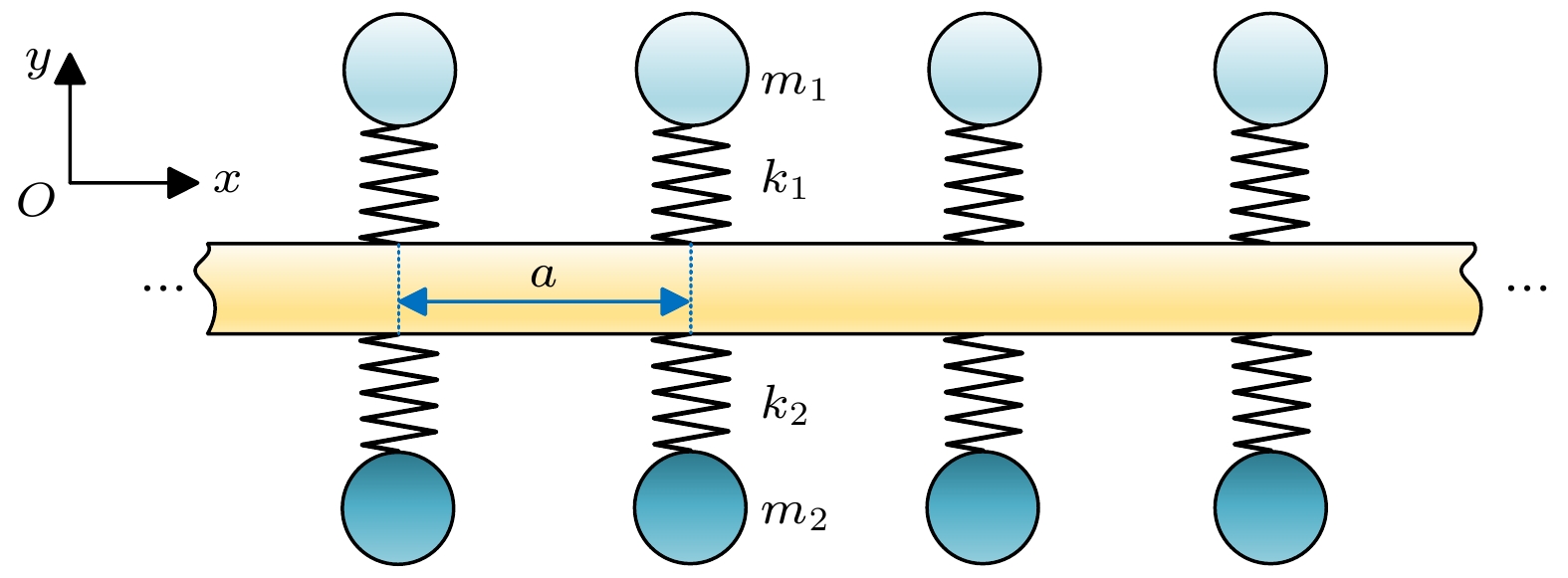
 下载:
下载:
